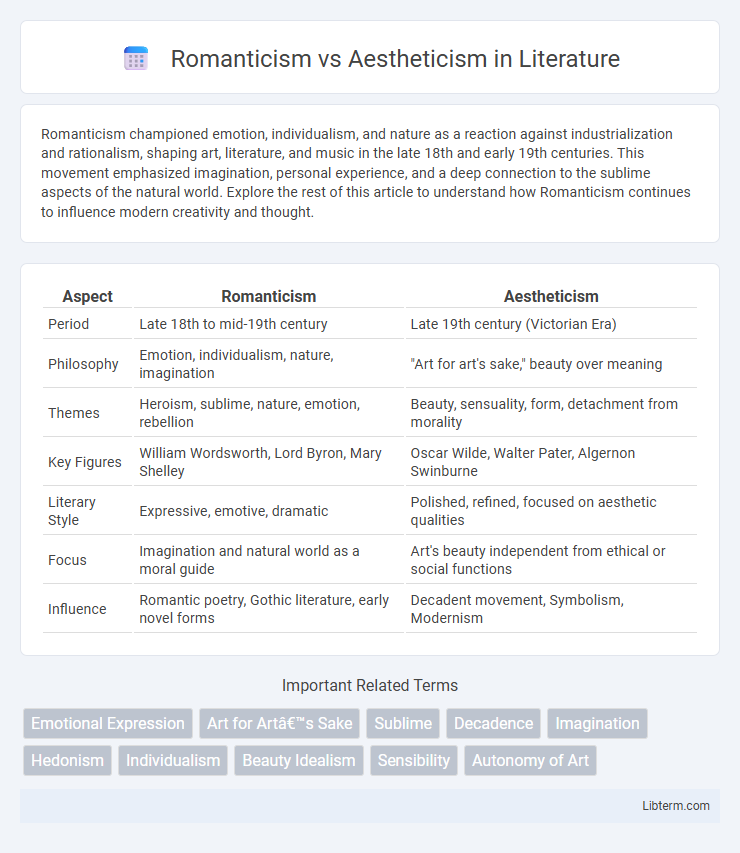Romanticism championed emotion, individualism, and nature as a reaction against industrialization and rationalism, shaping art, literature, and music in the late 18th and early 19th centuries. This movement emphasized imagination, personal experience, and a deep connection to the sublime aspects of the natural world. Explore the rest of this article to understand how Romanticism continues to influence modern creativity and thought.
Table of Comparison
| Aspect | Romanticism | Aestheticism |
|---|---|---|
| Period | Late 18th to mid-19th century | Late 19th century (Victorian Era) |
| Philosophy | Emotion, individualism, nature, imagination | "Art for art's sake," beauty over meaning |
| Themes | Heroism, sublime, nature, emotion, rebellion | Beauty, sensuality, form, detachment from morality |
| Key Figures | William Wordsworth, Lord Byron, Mary Shelley | Oscar Wilde, Walter Pater, Algernon Swinburne |
| Literary Style | Expressive, emotive, dramatic | Polished, refined, focused on aesthetic qualities |
| Focus | Imagination and natural world as a moral guide | Art's beauty independent from ethical or social functions |
| Influence | Romantic poetry, Gothic literature, early novel forms | Decadent movement, Symbolism, Modernism |
Introduction to Romanticism and Aestheticism
Romanticism, emerging in the late 18th century, emphasized emotion, individualism, and the sublime aspects of nature, reacting against the industrial revolution and Enlightenment rationalism. Aestheticism, developing in the late 19th century, prioritized "art for art's sake," focusing on beauty and sensory experience rather than moral or social themes. Both movements challenged prevailing artistic conventions but diverged in their core values, with Romanticism rooted in expressive depth and Aestheticism championing surface elegance and artistic autonomy.
Historical Context: Emergence of Both Movements
Romanticism emerged in the late 18th century as a reaction against the Industrial Revolution and Enlightenment rationalism, emphasizing emotion, nature, and individualism. In contrast, Aestheticism developed in the late 19th century, particularly in Victorian England, as a response to the moralism and utilitarianism of the era, advocating for "art for art's sake" and prioritizing beauty over social or political themes. Both movements reflect their distinct historical contexts by challenging prevailing cultural norms through their unique artistic philosophies.
Core Philosophies: Emotion vs. Beauty
Romanticism centers on the intense expression of emotion, valuing individual experience, imagination, and the sublime power of nature to evoke deep feelings. Aestheticism prioritizes beauty and sensory experience above moral or emotional content, emphasizing art for art's sake and the pursuit of aesthetic pleasure. While Romanticism explores emotional depth and personal truth, Aestheticism seeks to cultivate refined beauty as the ultimate artistic goal.
Key Figures in Romanticism
Key figures in Romanticism include William Wordsworth, Samuel Taylor Coleridge, and Lord Byron, whose works emphasized emotion, nature, and individualism. These poets rebelled against Enlightenment rationalism by exploring imagination and the sublime, shaping a movement centered on personal experience and dramatic expression. Their influence contrasted with Aestheticism's focus on art for art's sake, highlighting Romanticism's deep engagement with social and spiritual themes.
Prominent Aestheticism Influencers
Prominent Aestheticism influencers such as Oscar Wilde, Walter Pater, and Algernon Charles Swinburne championed the movement's principle of "art for art's sake," emphasizing beauty and sensory experience over moral or social themes that dominated Romanticism. These figures rejected Romanticism's emotional intensity and focus on individualism in favor of refined artistic expression and decadence, shaping late 19th-century art and literature with their innovative critiques of traditional values. Their works highlighted intricate craftsmanship and aesthetic pleasure, influencing modernist ideals by prioritizing form and style above narrative content.
Art and Literature: Thematic Contrasts
Romanticism in art and literature emphasizes emotion, individualism, and the sublime, often exploring themes of nature, heroism, and the supernatural. Aestheticism prioritizes beauty and sensory experience over moral or social messages, focusing on art for art's sake with themes centered on formal perfection and sensory appeal. While Romantic works convey deep emotional narratives and individual struggle, Aestheticism celebrates detached appreciation and visual elegance.
Nature and Imagination in Romanticism
Romanticism emphasizes the profound connection between humans and nature, portraying it as a source of spiritual renewal and emotional depth, where imagination transforms natural landscapes into symbols of individual freedom and sublime beauty. Imagination in Romantic art and literature serves as a powerful creative force that transcends reality, allowing for personal expression and the exploration of inner emotions. In contrast, Aestheticism focuses more on art for art's sake, prioritizing beauty and sensory experience over emotional or natural themes.
The Cult of Beauty in Aestheticism
The Cult of Beauty in Aestheticism championed art for art's sake, emphasizing visual harmony, elegance, and refined taste over emotional expression, contrasting sharply with Romanticism's focus on intense emotion, individualism, and the sublime. Leading figures like Oscar Wilde and Walter Pater promoted beauty as a moral and spiritual ideal, advocating for the sensory experience and formal perfection in artistic works. This movement prioritized aesthetic pleasure and decorative artistry, shaping late 19th-century art and literature by rejecting the Romantic emphasis on narrative depth and social commentary.
Lasting Impact on Modern Culture
Romanticism's lasting impact on modern culture is evident through its emphasis on emotional depth, individualism, and the celebration of nature, influencing contemporary art, literature, and music by inspiring personal expression and social awareness. Aestheticism shaped modern culture by prioritizing beauty and artistic form over moral or political themes, fostering movements like Art Nouveau and impacting design, fashion, and visual arts focused on style and sensory experience. Both movements contribute uniquely to modern cultural values, with Romanticism driving emotional authenticity and Aestheticism encouraging sensory appreciation and artistic innovation.
Conclusion: Reconciling Differences and Legacies
Romanticism and Aestheticism both emphasize individual expression and emotional depth, yet Romanticism prioritizes intense personal and societal engagement, while Aestheticism focuses on beauty and art for art's sake. Their legacies converge in modern artistic movements that embrace emotional resonance alongside visual and sensory appeal, demonstrating the enduring influence of these philosophies on literature, art, and culture. Understanding their differences enhances appreciation for how creativity balances passion with aesthetic innovation.
Romanticism Infographic

 libterm.com
libterm.com